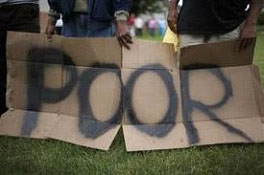『三分之一的美国人正过着贫困或接近贫困的生活,如果国家不改变政策,越来越多的美国人将身陷困境。』
The Poor, the Near Poor and You
贫者、近贫者与你
Nov. 23rd 2011 | from The New York Times
What is it like to be poor? Thankfully, most Americans do not know, at least not firsthand. And times are tough for the middle class. But everyone needs to rec

ognize a chilling reality: One in three Americans — 100 million people — is either poor or perilously close to it.
The Times’s Jason DeParle, Robert Gebeloff and Sabrina Tavernise reported recently on Census data showing that 49.1 million Americans are below the poverty line — in general, $24,343 for a family of four. An additional 51 million are in the next category, which they termed “near poor” — with incomes less than 50 percent above the poverty line.
As for all of that inspirational, up-by-their-bootstrap talk you hear on the Republican campaign trail, over half of the near poor in the new tally actually fell into that group from higher income levels as their resources were sapped by medical expenses, taxes, work-related costs and other unavoidable outlays.
The worst downturn since the Great Depression is only part of the problem. Before that, living standards were already being eroded by stagnating wages and tax and economic policies that favored the wealthy.
Conservative politicians and analysts are spouting their usual denial. Gov. Rick Perry and Representative Michele Bachmann have called for taxing the poor and near poor more heavily, on the false grounds that they have been getting a free ride. In fact, low-income workers do pay up, if not in federal income taxes, then in payroll taxes and state and local taxes.
Asked about the new census data, Robert Rector, an analyst at the conservative Heritage Foundation told The Times that the “emotionally charged terms ‘poor’ or ‘near poor’ clearly suggest to most people a level of material hardship that doesn’t exist.” Heritage has its own, very different ranking system, based on households’ “amenities.” According to that, the typical poor household has roughly 14 of 30 amenities. In other words, how hard can things be if you have a refrigerator, air-conditioner, coffee maker, cellphone, and other stuff?
The rankings ignore the fact that many of these are requisites of modern life and that things increasingly out of reach for the poor and near poor — education, health care, child care, housing and utilities — are the true determinants of a good, upwardly mobile life.
Government surveys analyzed by the Center on Budget and Policy Priorities indicate that in 2010, just over half of the country’s nearly 17 million poor children, lived in households that reported at least one of four major hardships: hunger, overcrowding, failure to pay the rent or mortgage on time or failure to seek needed medical care. A good education is also increasingly out of reach. A study by Martha Bailey, an economics professor at the University of Michigan, showed that the difference in college-graduation rates between the rich and poor has widened by more than 50 percent since the 1990s.
There is also a growing out-of-sight-out-of-mind problem. A study, by Sean Reardon, a sociologist at Stanford, shows that Americans are increasingly living in areas that are either poor or affluent. The isolation of the prosperous, he said, threatens their support for public schools, parks, mass transit and other investments that benefit broader society.
The poor do without and the near poor, at best, live from paycheck to paycheck. Most Americans don’t know what that is like, but unless the nation reverses direction, more are going to find out. (565 words)
热门推荐:
考研网校哪个好
新东方考研培训班
考研培训班
考研培训机构哪个好
考研英语网络课程
文都考研网校
北京考研培训班

